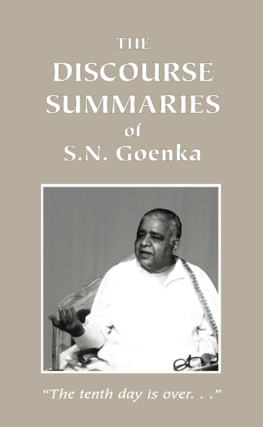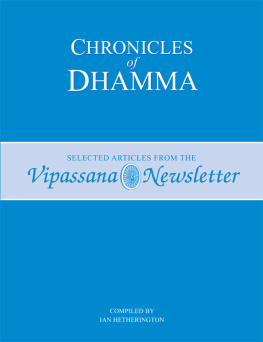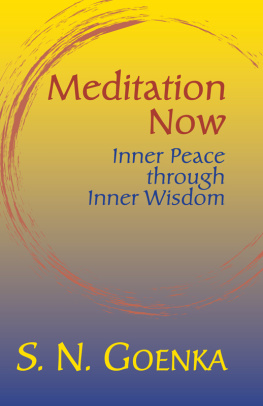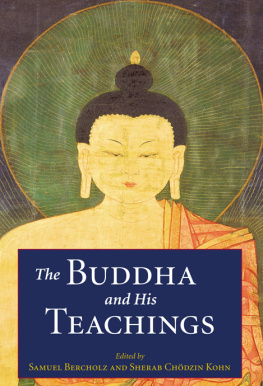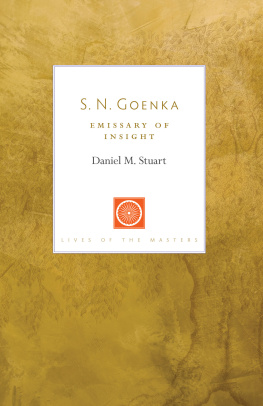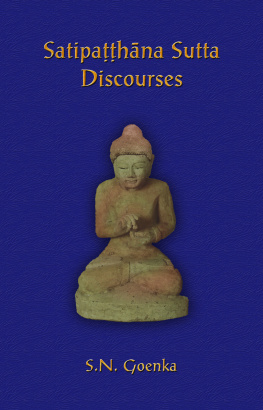S.N. Goenka - The Discourse Summaries of S.N. Goenka
Here you can read online S.N. Goenka - The Discourse Summaries of S.N. Goenka full text of the book (entire story) in english for free. Download pdf and epub, get meaning, cover and reviews about this ebook. year: 1987, publisher: Vipassana Research Publications - Onalaska, WA, USA, genre: Religion. Description of the work, (preface) as well as reviews are available. Best literature library LitArk.com created for fans of good reading and offers a wide selection of genres:
Romance novel
Science fiction
Adventure
Detective
Science
History
Home and family
Prose
Art
Politics
Computer
Non-fiction
Religion
Business
Children
Humor
Choose a favorite category and find really read worthwhile books. Enjoy immersion in the world of imagination, feel the emotions of the characters or learn something new for yourself, make an fascinating discovery.
The Discourse Summaries of S.N. Goenka: summary, description and annotation
We offer to read an annotation, description, summary or preface (depends on what the author of the book "The Discourse Summaries of S.N. Goenka" wrote himself). If you haven't found the necessary information about the book — write in the comments, we will try to find it.
The Discourse Summaries of S.N. Goenka — read online for free the complete book (whole text) full work
Below is the text of the book, divided by pages. System saving the place of the last page read, allows you to conveniently read the book "The Discourse Summaries of S.N. Goenka" online for free, without having to search again every time where you left off. Put a bookmark, and you can go to the page where you finished reading at any time.
Font size:
Interval:
Bookmark:
talks from a ten-day course
in Vipassana meditation
condensed by William Hart

Vipassana Research Publications - Onalaska, WA, USA
Vipassana Research Publications
(an imprint of)
PARIYATTI PUBLISHING
867 LARMON ROAD, ONALASKA, WASHINGTON 98570
WWW.PARIYATTI.ORG
Vipassana Research Institute, 1987, 1995
All rights reserved. No part of this book may be used or reproduced in any manner whatsoever without the written permission of the Vipassana Research Institute, Igatpuri, India, except in the case of brief quotations embodied in critical articles and reviews.
First edition:1987
First United States edition: 2000
eBook: 2012
ISBN: 978-1-928706-09-0 (paperback)
ISBN: 978-1-938754-08-1 (ePub)
ISBN: 978-1-938754-09-8 (Mobi)
Liberation can be gained only by practice, never by mere discussion, S. N. Goenka has said. A course in Vipassana meditation is an opportunity to take concrete steps towards liberation. In such a course the participant learns how to free the mind of the tensions and prejudices that disturb the flow of daily life. By doing so one begins to discover how to live each moment peacefully, productively, happily. At the same time one starts progressing towards the highest goal to which mankind can aspire: purity of mind, freedom from all suffering, full enlightenment.
None of this can be attained just by thinking about it or wishing for it. One must take steps to reach the goal. For this reason, in a Vipassana course the emphasis is always on actual practice. No philosophical debates are permitted, no theoretical arguments, no questions that are unrelated to ones own experience. As far as possible, meditators are encouraged to find the answers to their questions within themselves. The teacher provides whatever guidance is needed in the practice, but it is up to each person to implement these guidelines: one has to fight ones own battle, work out ones own salvation.
Given this emphasis, still some explanation is necessary to provide a context for the practice. Therefore every evening of a course Goenkaji gives a Dhamma talk, in order to put into perspective the experiences of that day, and to clarify various aspects of the technique. These discourses, he warns, are not intended as intellectual or emotional entertainment. Their purpose is simply to help meditators understand what to do and why, so that they will work in the proper way and will achieve the proper results.
It is these talks that are presented here in condensed form.
The eleven discourses provide a broad overview of the teaching of the Buddha. The approach to this subject, however, is not scholarly or analytical. Instead the teaching is presented in the way that it unfolds to a meditator: as a dynamic, coherent whole. All its different facets are seen to reveal an underlying unity: the experience of meditation. This experience is the inner fire that gives true life and brilliance to the jewel of the Dhamma.
Without this experience one cannot grasp the full significance of what is said in the discourses, or indeed of the teaching of the Buddha. But this does not mean that there is no place for an intellectual appreciation of the teaching. Intellectual understanding is valuable as a support to meditative practice, even though meditation itself is a process that goes beyond the limits of the intellect.
For this reason these summaries have been prepared, giving in brief the essential points of each discourse. They are intended mainly to offer inspiration and guidance to those who practice Vipassana meditation as taught by S. N. Goenka. To others who happen to read them, it is hoped that they will provide encouragement to participate in a Vipassana course and to experience what is here described.
The summaries should not be treated as a do-it-yourself manual for learning Vipassana, a substitute for a ten-day course. Meditation is a serious matter, especially the Vipassana technique, which deals with the depths of the mind. It should never be approached lightly or casually. The proper way to learn Vipassana is only by joining a formal course, where there is a suitable environment to support the meditator, and a trained guide. If someone chooses to disregard this warning and tries to teach himself the technique only from reading about it, he proceeds entirely at his own risk.
Fortunately courses in Vipassana meditation as taught by S. N. Goenka are now held regularly in many parts of the world. Schedules may be obtained by going to the Vipassana website: www.dhamma.org.
The summaries are based primarily on discourses given by Goenkaji at the Vipassana Meditation Center, Massachusetts, U.S.A. during August 1983. An exception is the Day Ten summary, which is based on a discourse given at the Center in August 1984.
While Goenkaji has looked through this material and approved it for publication, he has not had time to check the text closely. As a result, the reader may find some errors and discrepancies. These are the responsibility not of the teacher, nor of the teaching, but of myself. Criticism will be very welcome that might help to correct such flaws in the text.
May this work help many in their practice of Dhamma.
May all beings be happy.
William Hart
Sayings of the Buddha and his disciples that are quoted by Goenkaji are taken from the Collections of Discipline (Vinaya-piaka) and of Discourses (Sutta-pitaka) of the Pli Canon. (A number of quotations appear in both Collections, although in such cases only the Sutta references are given here.) There are also a few quotations from post-canonical Pli literature. In his talks, Goenkaji explains these passages more often by paraphrase than by word-for-word translation from the Pli. The intention is to give the essence of each passage in ordinary language, stressing its relevance to the practice of Vipassana meditation.
Where a Pli passage appears in the summary, the explanation given is that of Goenkaji in the discourse on which the summary is based. At the back of this book, in the section of Pli with English translation, an attempt has been made to give more exact renderings of the passages quoted, still emphasizing the point of view of a meditator.
In the text of the summaries, the use of Pli words has been kept to the necessary minimum. Where such words are used, for the sake of consistency their plurals are given in Pli form; for example, the plural of sakhra is sakhr, that of kalpa is kalp.
THE DISCOURSE SUMMARIES
Namo tassa bhagavato arahato
samm-sambuddhassa
Initial difficultiesthe purpose of this meditationwhy respiration is chosen as the starting pointthe nature of the mindthe reason for the difficulties, and how to deal with themdangers to be avoided
The first day is full of great difficulties and discomforts, partly because one is not accustomed to sit all day long and to try to meditate, but mostly because of the type of meditation that you have started practicing: awareness of respiration, nothing but respiration.
It would have been easier and faster to concentrate the mind without all these discomforts if, along with awareness of respiration, one had started repeating a word, a mantra, a gods name, or if one had started imagining the shape or form of a deity. But you are required to observe bare respiration, as it naturally is, without regulating it; no word or imagined form may be added.
Font size:
Interval:
Bookmark:
Similar books «The Discourse Summaries of S.N. Goenka»
Look at similar books to The Discourse Summaries of S.N. Goenka. We have selected literature similar in name and meaning in the hope of providing readers with more options to find new, interesting, not yet read works.
Discussion, reviews of the book The Discourse Summaries of S.N. Goenka and just readers' own opinions. Leave your comments, write what you think about the work, its meaning or the main characters. Specify what exactly you liked and what you didn't like, and why you think so.

